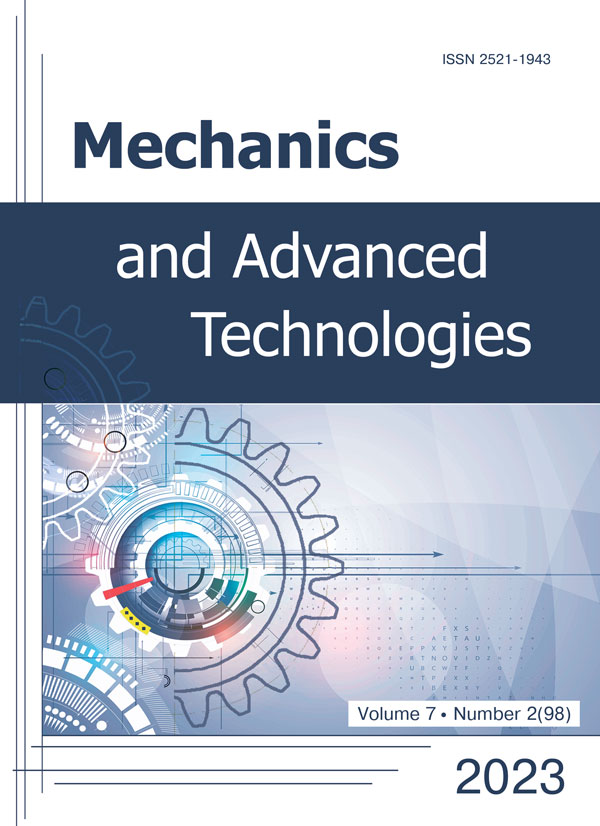Comparative analysis of hot reverse extrusion of hollow products from round and square blanks
DOI:
https://doi.org/10.20535/2521-1943.2023.7.2.288484Keywords:
finite element method, hot reverse extrusion, hollow product, round and square workpiece, temperature, forces, stresses, deformationsAbstract
Background. Modern production of hollow products by hot reverse extrusion poses the task of reducing energy consumption and reducing metal costs for the manufacture of such products. Such problems can be solved by using them for extruding square-shaped blanks.
Goal. Determination using the finite element method (FEM) of the parameters of hot reverse extrusion of hollow products from round and square blanks and comparison of the results of theoretical studies.
Methodology of implementation. Theoretical studies of force modes of extrusion, specific forces and stress-strain state of metal were carried out by simulation using MSE in the DEFORM software environment.
The results. Modeling of the process of hot reverse extrusion from low-carbon steel of a hollow product with protrusions on the end of the bottom part was carried out with the help of MSE. Round and square blanks are used. Extrusion forces, forces for removing punches from deformed blanks and forces for pushing out products from matrices are established. The distribution of specific forces on the deforming tool is revealed. The stress-strain state and temperature distribution in the deformed metal at the end of extrusion were determined. Evaluation of the working of the metal structure by hot plastic deformation was carried out and the obtained parameters were compared.
Conclusions. The use of square-shaped blanks during hot reverse extrusion of hollow products is substantiated.
References
- Forging and stamping: Handbook, Vol. 2: Hot stamping, E. I. Sеmenov Ed. Moscow: Mechanical Engineering, 1986, 592 p.
- V. N. Danchenko, A. A. Milenin and V. I. Kuzmenko, Computer modeling of metal pressure processing processes. Numerical methods. Dnepropetrovsk: System Technologies, 2008, 448 p.
- S. A. Snitko and V. L. Kalyuzhny, “Finite-element modeling of multi-pass deformation during the production of railway wheels”, Bulletin of NTUU "KPI", series Mechanical Engineering, no. 11, pp. 106–112, 2011.
- V. L. Kaliuzhniy, L. I. Aliieva, I. S. Aliiev and V. N. Hornostai, "Hot die forging of hollow products from high-strength aluminum alloy with specified mechanical properties", Blank production in mechanical engineering, vol. 16, no. 12, pp. 18-25, 2018.
- X. Hu, R. B. Mei, F. Zhu, Y. Fan, Y. B. Liang, X. B. Wang, D. G. Wang and Z. R. Jing, “Numerical Simulation for Microstructure Evolution in In718 Alloy During Cylindrical Cup Backward Extrusion”, Advanced Materials Research, vol. 650, pp. 92–97, 2013. DOI: https://doi.org/10.4028/www.scientific.net/AMR.650.92.
- P. Szota, S. Mroz, A. Stefanik, K. Laber and R. Mola, “Theoretical and experimental analysis of the backward extrusion process with a rotational die of AZ31 alloy”, Metallurgy, vol. 60, no. 1–2, pр. 36–38, 2021.
- S. H. Hosseini, K. Abrinia and G. Faraji, “Applicability of a modified backward extrusion process on commercially pure aluminum”, Materials and Design, vol. 65, pp. 521–528, 2015. DOI: https://doi.org/10.1016/j.matdes.2014.09.043.
- S. Kuhnke, V. Sanabria, F. Gensch, R. Nitschke and S. Mueller, “Numerical Investigations on Material Flow During Indirect Extrusion of Copper-Clad Aluminum Rods”, Front. Mater., vol. 7, pp. 1–10, Jun. 2020. DOI: https://doi.org/10.3389/fmats.2020.00157.
- Ban Bakir Alamer, “The Study of Stress State in Indentation of a Flat Punch with Rounded Edge in Axisymmetric Backward Extrusion”, Eng. & Tech. Journal, vol. 31, no. 9, pp. 1765–1778, 2013. DOI: https://doi.org/10.30684/etj.2013.82188.
- J.-T. Yeom, J. H. Kim, J.-K. Hong, N.-K. Park, C. S. Lee, “Prediction of Microstructure Evolution in Hot Backward Extrusion of Ti-6Al-4V Alloy”, Journal of Metallurgy, vol. 2012, no. 6, p. 989834, 2012. DOI: https://doi.org/10.1155/2012/989834.
- R. Boroumand, A. Babaei, H. M. Bashiri and M. H. Zaheri, “Processing MMC tubes via friction stir backward extrusion”, Karafan Journal, vol. 19, no. 1, pp. 225–241, 2022.
- D. J. Yoon, E.-Z. Kim, K. H. Na and Y.-S. Lee, “A Study on the Forming Characteristics of AZ 31B Mg Alloy in a Combined Forward–Backward Extrusion at Warm Temperatures”, Appl. Sci., vol. 8, no. 11, p. 2187, 2018. DOI: https://doi.org/10.3390/app8112187.
Downloads
Published
How to Cite
Issue
Section
License
Copyright (c) 2023 Володимир Калюжний, Станіслав Ситник, Володимир Левченко

This work is licensed under a Creative Commons Attribution 4.0 International License.
Authors who publish with this journal agree to the following terms:
- Authors retain copyright and grant the journal right of first publication with the work simultaneously licensed under CC BY 4.0 that allows others to share the work with an acknowledgement of the work's authorship and initial publication in this journal.
- Authors are able to enter into separate, additional contractual arrangements for the non-exclusive distribution of the journal's published version of the work (e.g., post it to an institutional repository or publish it in a book), with an acknowledgement of its initial publication in this journal.
- Authors are permitted and encouraged to post their work online (e.g., in institutional repositories or on their website) prior to and during the submission process, as it can lead to productive exchanges, as well as earlier and greater citation of published work











